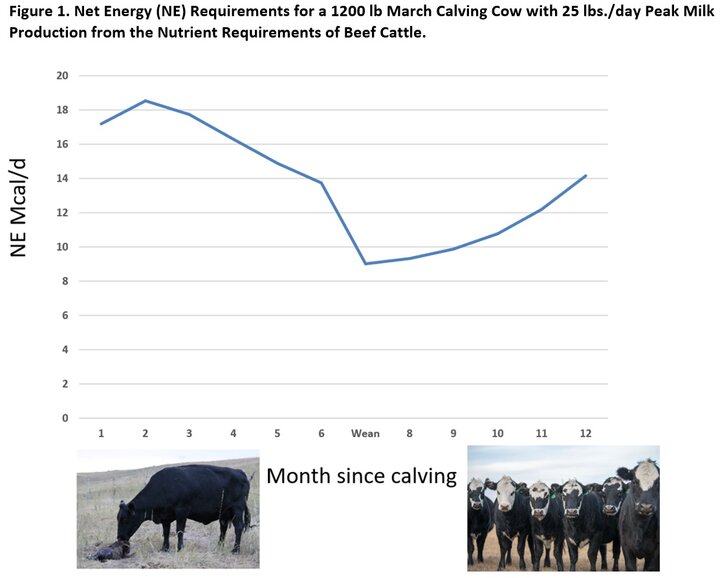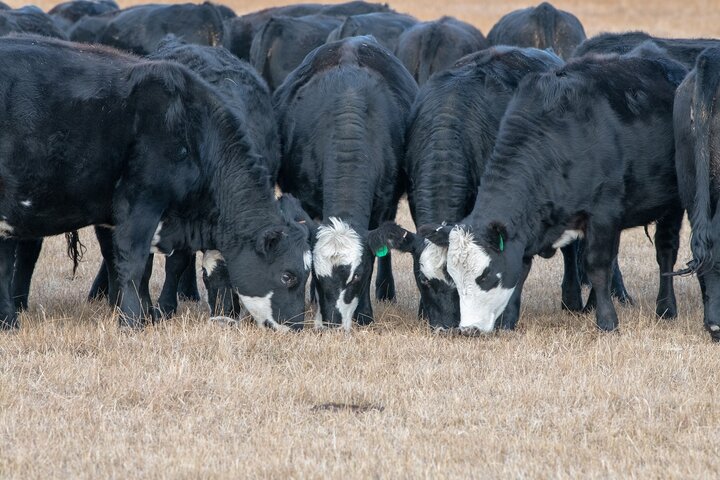This article was originally featured in Progressive Cattle.
During any given production year on the ranch, cows/heifers are faced with nutritional and environmental stressors. They have periods of high and low nutritional demands. Knowing the stress periods that can result in nutrient deficiencies is where you, the rancher, must manage to your and your ranch’s best ability to help the cow/heifer meet these nutritional challenges. How well do you know your ranch? Does it have any advantages or shortcomings that you can utilize or need to augment to affordably meet any nutritional challenges? Some examples of advantages could be wet meadows, irrigated pasture, dryland annuals, windbreaks, proximity to crop residue, etc.
What can you afford? Realizing that you cannot always afford to meet the cow’s nutrient requirements will help you in your nutritional plan, i.e., put body condition on your cows when their energy requirements are the lowest (Fig. 1), and let the cow use that body condition as an energy source when you cannot afford to meet her requirements. Feed costs are a major expense for any cow/calf operation. As such, knowing what type of supplement is needed, when it is needed, and how to compare supplements based on nutrient content will help you make better decisions on needed supplement purchases.

Another important question is, “What are the cow effects of your management?” Do you have dystocia problems? Are you managing your cowherd so that the cows are rebreeding every year? Are you managing to the genetics of your herd? Are your pastures/forages sustaining from year-to-year? A final question to ask is, “What are the calf effects of your management of the dam?” When calves are born are they vigorous and able to get up and suckle the dam? Are the cows producing sufficient colostrum? Is there sickness in your calves? What are your weaning weights? Questions like these can help in your management to ensure that you have healthy calves and cows that have a calf every year.
Body condition scores (BCS) describe the relative fatness of a cow through the use of a nine-point scale. Body condition scoring is an effective management tool to evaluate the nutritional status of the herd. For a spring calving herd, the key times to BCS your gestating females are late summer (early wean if needed), fall, weaning, 45 days after weaning, and 90 days before calving (your last opportunity to economically put condition on your cows/heifers). The most economical time to put condition on thin cows is after weaning. Ninety days before calving is the last opportunity to put condition on cows economically. If possible, sort thin and adequate condition scores into different feeding groups. This will help develop a feeding plan that will maintain cows in adequate body condition or will provide needed weight gain for thin cows prior to and through the breeding season. Having an inventory of your feed on hand for both quantity and quality will help you with your feeding and supplement decisions. Testing your feedstuffs will enable you to have a more strategic feeding program and you will be able to prioritize your quality feedstuffs to younger and thinner females.
By looking at Figure 1, we see that the cow’s highest energy requirement is at peak milk production, about 60 days after calving. This coincides with the breeding season. She has calved, is producing milk, is recovering from calving, and getting ready for breeding. To help prepare your mature cows for this, having them in a body condition score (BCS) of at least 5 at calving is recommended. The heifer is still growing, and it is recommended that she be in a BCS of 6 at calving. Separating heifers from the mature cows in the herd should be done at least three weeks prior to calving. First-calf heifers decrease their daily dry matter intakes by 17 percent in the three weeks prior to calving. Feeding an energy and protein dense diet to heifers is necessary to compensate for this reduced intake at calving.
In late gestation the energy requirements of a mature, 1,200 lb cow are relatively low (9– 11 lb total digestible nutrients or TDN per day, 2 lb crude protein per day). As that cow grazes dormant range or low-quality forages, supplementation of 2– 2.5 lb of a 20– 25 percent crude protein (CP) source would meet the cow’s maintenance demands at this stage of production. As a mature cow enters calving and lactation, her protein and energy requirements increase. A lactating cow at peak lactation (60– 80 days postpartum) has an energy demand of 15– 16 lb of TDN per day. There is a shift in the cow’s first limiting nutrient from protein to energy.
Body condition of beef cows that calve in the spring influences productivity of the herd. As body condition of a cow increases at calving for March calving cows, the interval from calving to the first estrus, known as the postpartum anestrous interval, is reduced (Table 1). Thin (BCS 4 or less) cows are slower to rebreed after calving compared to cows in moderate body condition.

As you consider the nutrition requirements of your cows and heifers, keep in mind that their requirements change depending on their stage of production. Using body condition scoring will help you evaluate the nutritional status of your herd. Keep in mind that how you manage these nutritional requirements can not only have cow effects but also calf effects.
Sources
Jenkins, K.H. and M.L. Bremer. 2015. Supplementation Needs for Gestating and Lactating Beef Cows and Comparing the Prices of Supplement Sources. Nebraska Extension NebGuide (G2268)
Houghton, P. L. , R. P. Lemenager, L. A. Horstman, K. S. Hendrix and G. E. Moss. 1990. Effects of body composition, pre- and postpartum energy level and early weaning on reproductive performance of beef cows and preweaning calf gain. 1990, Journal of Animal Science, 68:1438-1446.
Rasby, R.J., A. Stalker, and R.N. Funston. 2014. Body Condition Scoring Beef Cows: A Tool for Managing the Nutrition Program for Beef Herds. Nebraska Extension (EC281)
Interviews with the authors of BeefWatch newsletter articles become available throughout the month of publication and are accessible at https://go.unl.edu/podcast.

